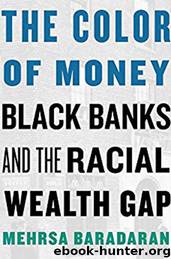The Color of Money by Mehrsa Baradaran

Author:Mehrsa Baradaran
Language: eng
Format: azw3, epub
ISBN: 9780674970953
Published: 2019-04-04T05:00:00+00:00
The Free Market Confronts Black Poverty
No sooner had the complicated, overdue, and incomplete racial turmoil of the civil rights era subsided than a rewriting of its history began. The story was that the civil rights laws had permanently altered race relations in America, dividing history into a racist past and a color-blind present. Civil rights was a fait accompli, justice had finally been achieved, and Ameri ca’s institutions were at last only concerned with the “content of one’s character." Even Dr. King’s complicated legacy was recast. King was now seen as a singular American hero who sought and ushered forth racial harmony, finally reconciling America’s stated ideals of equality with its dissonant history. This retelling not only erased the long history of injustice and its effects, which in fact had not abated in the least; it also pushed the burden of economic disparity squarely onto the black population.
On the campaign trail and as president, Jimmy Carter portrayed the country as postracial. He chastised his Democratic primary opponent, Jesse Jackson, for overemphasizing racial problems, which he referred to as “an issue that’s already divided the people," yet he enthusiastically embraced the once-divisive leader of the previous era, stating “I see an America in which Martin Luther King’s dream is our national dream."1 President Ronald Reagan also harshly denounced racism and embraced King’s dream. When Reagan made King’s birthday a national holiday in 1983, he announced, “We’ve made historic strides since Rosa Parks refused to go to the back of the bus. As a democratic people, we can take pride in the knowledge that we Americans recognized a grave injustice and took action to correct it."2 Yet he had consistently maintained opposition to civil rights laws because he believed them to be unnecessary government intrusions into private markets.3
Black poverty came to be seen as a direct result of a culture that lacked responsibility, work ethic, and “family values." Having achieved racial equality, what else could explain the wide wealth gap? Government interventions and the welfare state had allegedly created perverse incentives for blacks to avoid employment and have children out of wedlock.4 President Reagan attacked welfare spending, characterizing it as tax dollars being spent on “welfare queens" feasting on T-bone steak while hardworking Americans “were standing in the checkout line with [their] package of hamburgers." In railing against welfare, Reagan used the example of a particular black female fraudster who had snatched unearned privileges by exploiting the welfare system at the expense of honest taxpayers. This was an inaccurate picture of welfare, as whites received the large majority of welfare benefits and welfare fraud was rare. However, the depiction of the black population as riddled with crime and drugs, unwilling to work, and living comfortably off government largesse had remarkable durability.5
It is worth distilling this message in order to fully appreciate the irony. The story was that after decades of New Deal-era federal subsidies had created a white middle class, reinforced a segregated black underclass, and created cyclic poverty that made it
Download
This site does not store any files on its server. We only index and link to content provided by other sites. Please contact the content providers to delete copyright contents if any and email us, we'll remove relevant links or contents immediately.
| African-American Studies | Asian American Studies |
| Disabled | Ethnic Studies |
| Hispanic American Studies | LGBT |
| Minority Studies | Native American Studies |
Cecilia; Or, Memoirs of an Heiress — Volume 1 by Fanny Burney(31333)
Cecilia; Or, Memoirs of an Heiress — Volume 3 by Fanny Burney(30934)
Cecilia; Or, Memoirs of an Heiress — Volume 2 by Fanny Burney(30889)
The Great Music City by Andrea Baker(21313)
We're Going to Need More Wine by Gabrielle Union(18073)
Bombshells: Glamour Girls of a Lifetime by Sullivan Steve(13108)
Pimp by Iceberg Slim(12931)
All the Missing Girls by Megan Miranda(12748)
Fifty Shades Freed by E L James(12451)
Norse Mythology by Gaiman Neil(11883)
Talking to Strangers by Malcolm Gladwell(11877)
Crazy Rich Asians by Kevin Kwan(8349)
Mindhunter: Inside the FBI's Elite Serial Crime Unit by John E. Douglas & Mark Olshaker(7834)
The Lost Art of Listening by Michael P. Nichols(6474)
Enlightenment Now: The Case for Reason, Science, Humanism, and Progress by Steven Pinker(6405)
Bad Blood by John Carreyrou(5769)
The Four Agreements by Don Miguel Ruiz(5511)
Weapons of Math Destruction by Cathy O'Neil(5037)
We Need to Talk by Celeste Headlee(4869)
